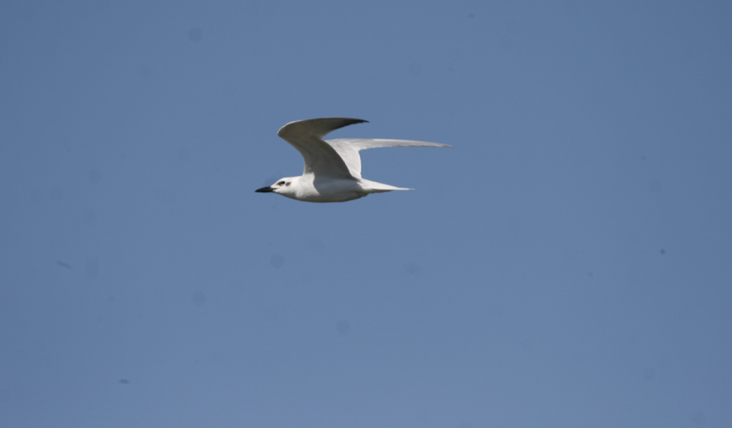Wayne R. Petersen

Wayne R. Petersen
For the second issue in a row your At a Glance editor is offering readers a gift mystery species to identify—at least perhaps it will feel like a gift. Clearly the bird in question is either a gull or a tern. Most of its features lead more in the direction of a tern, such as the bird’s noticeably pointed wings with a sharp crook at the “elbow,” possibly a sharp-pointed tail, a stout black bill, a dark spot behind the eye—the latter two also possible gull features—and an overall white or frosty coloration, although some gull plumages may appear similarly pale. Note also the hint of a dusky tone under the primaries—another feature shared by many gulls and terns.
Given that several of these features are shared or slightly ambiguous, a more thorough examination of the photo is in order. First the pointed wings: generally, even a small gull such as a Bonaparte’s Gull in nonbreeding plumage would be unlikely to present such a pointed wing aspect, and its wings would not appear so narrow, especially at the elbow. Additionally, a Bonaparte’s Gull typically appears grayer above and shows at least some black on the wingtips (which would at least be visible on the bird’s right wing), as well as a narrow wedge of white along the leading edges of the wings. And finally the dark bill of a Bonaparte’s Gull would appear longer, slimmer, and less stout than that of the mystery bird.
Having thus removed gulls as options for the mystery bird, clearly then, the bird is a tern. In breeding plumage all of the regularly-occurring Massachusetts tern species have black caps with the exception of the Black Tern whose entire head is black. Accordingly, the mystery tern has to be either a juvenile/immature tern or an adult in nonbreeding plumage. Given that most terns in nonbreeding plumage have either a lightly streaked or a clear white forehead and crown, and they exhibit a black “scarf” on the back of the head and nape, the choices are quickly limited to either Gull-billed Tern or Forster’s Tern. Forster’s Terns in nonbreeding plumage characteristically have a dark eye patch, but they also frequently have some dusky streaking on the back of the head, though seldom as black or as extensive as in other similarly sized tern species. A close look at the mystery tern shows that its head is completely white with no dusky on the top, back, or nape. The only prominent black on head of the mystery tern is the dusky patch behind the eye, not through the eye or extending continuously behind the eye. Combined with the striking whiteness of the mystery bird, these features all point to an adult Gull-billed Tern (Gelochelidon nilotica) in nonbreeding plumage.
Most Gull-billed Terns along coastal Massachusetts are rare late spring or early summer visitors, and occasionally post hurricane victims in the fall. The majority of Gull-billed Terns appearing in the Bay State are in adult plumage. The author captured the image of this Gull-billed Tern in nonbreeding plumage at Merritt Island, Florida, in late January 2011.